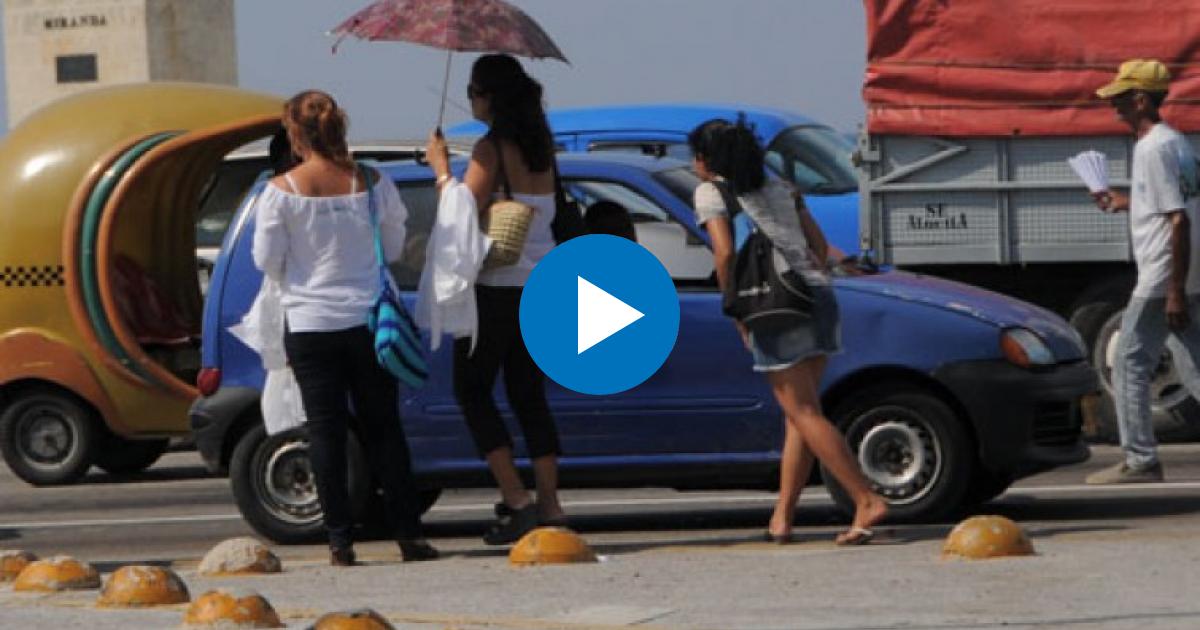
Few things highlight the precarious Cuban infrastructure as much as transportation; however, few things also manage to bring out the best in Cubans like this one.
Getting around Cuba from one place to another is one of the biggest problems Cubans face. On one hand, public transportation, with its limited vehicle fleet and still inadequate frequency of trips, cannot meet the demand, and on the other hand, it is inevitable to deal with the challenge of having to go somewhere at least once a week, and in most cases, once a day. One must go to work every day, one cannot miss medical appointments, occasionally one also needs to have a little fun, and if one lives in a not-so-small city, all of this at some point requires taking some means of transportation.
As a solution to these deficiencies and difficulties, during the toughest years of the Special Period, a mode of transportation that had existed many years earlier gained popularity: hitchhiking. Although this is not exclusive to Cuba, as demonstrated by its various names such as aventón, hacer autostop, hacer dedo, get a ride, hitchhiking, and many more, it is something that characterizes the Cuban, with their spark and willingness to help, contributing to the unique appearance of Cuban streets.
We are talking about hitchhikers, who daily venture to get on the car, motorcycle, or truck of a stranger to take advantage of their journey and reach their destination. In Cuba, almost anyone can hitch a ride. While it is true that women are the ones who more frequently make this their usual way of moving around, it is also true that there are many men, of various ages and backgrounds, who muster the necessary dose of patience and use all their resources to successfully reach their desired place.
Strategies are as diverse as the people who implement them. There are those who are impressively quick and successful, and those who even end up getting sunburned while managing to have a stranger accompany them on their journey.
A certain dose of sexism and even seduction makes it more likely for women to be accepted into someone else's car than men because Cuba is a society where most vehicles are driven by men. This created charming scenes of girls who would stop to pick up bottles in advance so that their friends or partners could get in the car before it started moving. Of course, there are drivers who, whether reluctantly or not, decide to accept the unexpected passenger, but there are also those who refuse to transport them and choose to continue driving without the boy and, evidently, without the girl.
Many diverse stories are woven around this way of traveling for free from one place to another. As may be expected, situations of empathy can arise that turn the brief coexistence into something pleasant for both the driver and the hitchhiker, and there can also be uncomfortable moments: for example, when one of the two is shy and does not dare to break the silence, a simple thank you at the end of the journey concludes a silent, fortuitous encounter.
However, on some occasions, both some of the beneficiaries and some of the supportive drivers report frankly unpleasant experiences. There will always be uncivil, rude, and disrespectful passengers, and drivers who will take advantage of the power that comes from controlling the vehicle, to cross established boundaries, violate, or assault those who have requested to go with them. Fortunately, these incidents are the least common, as what distinguishes this phenomenon in Cuba is camaraderie, solidarity, empathy, and gratitude.
As we mentioned, this phenomenon is not exclusive to the largest of the Antilles, but its massiveness, dissemination, and extension to all areas, sectors, and people in Cuba does seem to be. Perhaps some take a little longer or a little less time, perhaps this medium causes the route to lengthen or deviate a bit, but in Cuba, people move in bottles.
Seeing the success of these transportation methods, the government created the figure of the "amarillo," who was responsible for stopping drivers of trucks, cars, or state-owned buses to occupy the empty seats and thus take advantage of their routes and optimize fuel expenses for the companies. This meant a reduction in opportunities for the "botelleros" since the "amarillos" usually set up their points before traffic lights or intersections—places where the "botelleros" were located—so they had to start dealing with the fact that cars that used to come empty began to parade full before their eyes. However, if the weather, the time spent, and the risks had never been a deterrent for the daring of a "botellero," this was not either, and to this day, they continue to find ways to carve out a niche for themselves and earn a yes.
The fact is that in Cuba, every day, many strangers come together to lend a hand and offer transportation, thus demonstrating that where governments do not reach or when solutions to problems do not exist, there is always a Cuban ready to help, support, and contribute. This is one of the many small gestures of daily life on an Island that is built and sustained thanks to the hundreds of thousands of citizens who inhabit it.
What do you think?
COMMENTFiled under: